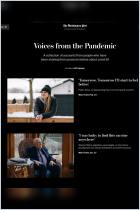加入 getAbstract 阅读摘要

加入 getAbstract 阅读摘要
Cassandra Alexander
Year of the Nurse
A 2020 Covid-19 Pandemic Memoir
Caskara Press, 2021
看看什么内容?
An American nurse gives a deeply unsettling account of the COVID-19 crisis.
Recommendation
When the World Health Organization designated 2020 the Year of the Nurse, little did nurses in the United States know they would be sent into the fight against Covid-19 like soldiers into war — only with insufficient equipment and less support. In this blunt and often angry account, Cassandra Alexander, an experienced ICU nurse, recounts fighting for people’s lives on a daily basis, while government, society and even her family undermine and discredit her efforts and those of other health professionals.
Summary
About the Author
Registered nurse Cassandra Alexander has experience in burn, critical care transport and ICU.





















Comment on this summary